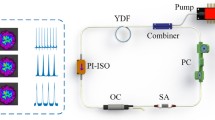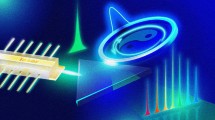Abstract
The tunability, high power and flexible picoseconds-pulse time structure of terahertz (THz) radiation make the THz free-electron laser (FEL) a very attractive THz source of coherent radiation. This paper focuses on the development and perspectives of THz radiation sources based on the FEL. The principles of the low gain THz FEL oscillator, the SASE THz FEL amplifier and the supperradiant THz FEL are reviewed briefly, and the key technologies of THz FEL, such as injector, accelerator, undulator and optical cavity, are discussed, respectively. The current status of and future prospects for THz radiation sources based on the FEL are emphasized in this paper. Recent research and development have shown bright future in free-electron laser (FEL) THz radiation sources. The potential applications can be carried out in the field of imaging, material research, biology medicine, communication, diagnostics and many others.
Similar content being viewed by others
References
Shumyatsk P, Alfano R R. Terahertz sources. J Biomed Opt, 2011, 16: 033001
Gallerano G P, Biedron S. Overview of terahertz radiation sources. In: Proceeding of the 2004 FEL conference. Trieste, 2004. 216–221
Krishnagopal S, Kumar V. Free electron laser. Radiat Phys Chem, 2004, 70: 559–569
Committee on Free Electron Lasers and Other Advanced Coherent Light Sources, National Research Council. Free Electron Lasers and Other Advanced Source of Light: Scientific Research Opportunities. Washington: National Academy Press, 1994
Saldina E L, Schneidmillera E A, Yurkovb M V. The Physics of Free Electron Lasers-An Introduction. Phys Report, 260: 187–327
Wiedemann H. Particle Accelerator Physics. Berlin: Springer, 1993
Rana S J. Free Electron Laser. Project report: Synchrotron radiation. 2010
Kim K J, Sessler A. Free-Electron Lasers: present status and future prospects. Science, 1990, 250: 88–93
Brau C A. Free-Electron Lasers. Oxford: Academic Press, 1990
Kim K J. Three-dimensional analysis of coherent amplification and self-amplified spontaneous emission in free-electron lasers. Phys Rev Lett, 1986, 57: 1871–1874
Sung C, Tochitsky S Y, Ralph J E, et al. High-gain seeded FEL amplifier tunable in the terahertz range. In: Proceedings of the 27th International Free Electron Laser Conference, California, 2005. 87–90
Tochitsky S Y, Sung C, Trubnick S E, et al. High-power tunable 0.5–3 THz radiation source based on nonlinear difference frequency mixing of CO2 laser lines. J Opt Soc Am B, 2007, 24: 2509–2515
Kii T, Higashimura K, Zen H, et al. Design study of THz seeded FEL using a photocathode RF gun and short period undulator. In: Proceeding of the 30th FEL Conference. Gyeongju, 2008. 196–199
Seo Y H, Lee W H. Superradiant undulator radiation of periodic intense electron bunches in a cavity. IEEE Trans Plasma Sci, 2010, 38: 2016–2020
Socol Y, Faingarsh A, Peleg S, et al. The ISRAELI EA-FEL upgrade toward long pulse operation for ultra-high resolution single pulse coherent spectroscopy. In: Proceedings of 27th FEL Conference, Stanford, 2005. 297–300
Lidia S, Sannibale F, Staples J, et al. Development of a high-brightness VHF electron source. In: Proceeding of ERL07. Darebury, 2007
Yang F J, Kan K, Kondoh T, et al. Femtosecond electron beam dynamics in photocathode accelerator. In: Proceedings of PAC07. New Mexico, 2007. THPMN039
Dyunin E, Lurie Y, Pinhasi Y, et al. A new THz FEL development project. In: IEEE 25th Convention of Electrical and Electronics Engineers in Israel. Israel, 2008. 825–829
Gavrilov N G, Knyazev B A, Kolobanov E I, et al. Status of the Novosibirsk high-power terahertz FEL. Nucl Instr Meth A, 2007, 575: 54–57
Bakkera R J, van der Geera C A J. Commissioning the FELIX bunching system. Nucl Instr Meth A, 1991, 30: 199–202
Sprangle P, Penano J, Hafizi B, et al. High average current electron guns for high power free electron laser. Phys Rev ST Accel Beams, 2011, 14: 020702
Janssen D, Buttig H, Evtushenko P, et al. Superconducting RF guns for FELs. Nucl Instr Meth A, 2004, 528: 305–311
Hajima R. Overview of energy-recovery linacs. In: Asian Particle Accelerator Conference, Indore, 2007. MOYMA01
Tecimer M, Brunel L C, van Tol J, et al. A design study of a FIR/THz FEL for high magnetic field research. In: Proceeding of FEL 2006, Bessy, 2006. TUPPH009
Carr G L, Martin M C, McKinney W R, et al. High-power terahertz radiation from relativistic electron. Nature, 2000, 420: 153–156
Minehara E J, Sugimoto M, Sawamura M, et al. Development of the JAERI FEL driven by a superconducting accelerator. In: Particale Accelerator Conference, Dallas, 1995. 159–161
Lee B C, Jeong Y U, Park S H, et al. High-power infrared free electron laser driven by a 352 MHz superconducting accelerator with energy recovery. Nucl Instr Meth A, 2004, 528: 106–109
Kubarev V V. Losses in optical resonator of Novosibirsk Terahertz FEL: Theory and experiment. In: Proceedings of FEL 2007. Novosibirsk, 2007. MOPP042
Barnetta G A, Bensonb S V, Madey J M J, et al. Hole coupling experiments on the Mark III FEL. Nucl Instr Meth A, 1995, 358: 311–314
Lehnert U, Michel P, Seidel W, et al. First experiences with the FIR-FEL at ELBE. In: Proceeding of FEL, Novosibirsk, 2007. MOPPH036
Matveenko A N, Shevchenko O A, Tcheskidov V G, et al. Electron Outcoupling Scheme for the Novosibirsk FEL. In: Proceedings of FEL, Novosibirsk, 2007. 204–2206
Neil G R, Behre C, Benson S V, et al. The JLab high power ERL light source. Nucl Instr Meth A, 2006, 557: 9–15
Kim K J, Xie M. Stability and performance of CDRL-FEL. Nucl Instr Meth A, 1991, 304: 146–154
Tecimer M, Oepts D, Wuensch R, et al. Study of partial-waveguide rf-linac FELs for intense THz pulse generation. Nucl Instr Meth A, 2004, 528: 139–145
Doria A, Asgekar V B, Esposito E, et al. Long wavelength compact-FEL with controlled energy-phase correlation. Nucl Instr Meth A, 2001, 475: 296–302
Tecimer M, Jiang H, Hallman S, et al. Variable height slot-outcoupling for the compact UH THz-FEL. Nucl Instr Meth A, 2004, 528: 146–151
Oepts D, van der Meer A F G. Start-up and radiation charcteristics of the FELIX long wavelength FEL in the vicinity of a tuning gap. In: Proceedings of FEL2010, Malmo, 2010. 323–327
Dattoli G, Doria A, Giannessi L, et al. Waveguide free electron laser: gain inhomogeneous broadening and saturation. Opt Comm, 1996, 123: 535–542
Doria A, Gallerano G P, Renieri A. Kinematic and dynamic properties of a waveguide FEL. Opt Comm, 1991, 80: 417–424
Bartolini R, Doria A, Gallerano G P, et al. Theoretical and experimental aspects of a waveguide FEL. Nucl Instr Meth A, 1991, 304: 417–420
Ciocci F, Dattoli G, Giannessi L, et al. Inhomogeneous broadening effects in a waveguide free-eletron laser. IEEE J Quantum Electron, 1994, 20: 180–184
Tecimer M. Numerical studies of (partial-) waveguide FELs. Nucl Instr Meth A, 2002, 483: 521–526
Akberdin A A, Kazakevich G M, Kulipanov G N, et al. A compact far infrared free electron laser. Nucl Instr Meth A, 1998, 405: 195–199
Jeong Y U, Kazakevich G M, Park S H, et al. High power table-top THz free electron laser and its application. Nucl Instr Meth A, 2007, 575: 58–59
Huang Y C, Chiang A C, Lin Y Y. A high-gain, transform-limited far-infrared free-electron laser amplifier seeded by a THz single-frequency difference frequency generator. In: Proceedings of APAC. Gyeongiu, 2004. 264–266
Abramovich A, Arensburg A, Chairman D, et al. First operation of the Israeli Tandem electrostatic accelerator freeelectron laser. Nucl Instr Meth A, 1998, 407: 16–20
Socol Y, Faingarsh A, Peleg S, et al. The Israelia FEL upgrade toward long pulse operation for ultra-high resolution single pulse coherent spectroscopy. In: Proceeding of the 27th international FEL conference. Stanford, 2005. TUPP034
Crosson E R, James G E, Schwettman H A, et al. Multi-user operation at an FEL facility. Nucl Instr Meth A, 1998, 144: 25–31
Oepts D, van der Meer A F G, van Amersfoort P W. The free electron laser user facility FELIX. Infrar Phys Technol, 1995, 36: 297–308
Kulipanov G N, Gavrilov N G, Knyazev B A, et al. Research highlights from the Novosibirsk 400W average power THz FEL. Terahertz Sci Technol, 2008, 1: 107–125
Prazeres R, Glotin F, Ortega J M, et al. Study of the “CLIO” FEL properties at long wavelengths. Nucl Instr Meth A, 2000, 445: 204–207
Klopf J M, Greer A, Gubeli J, et al. The Jefferson Lab high power THz user facility. Nucl Instr Meth A, 2007, 582: 114–116
Akberdin R R, Chesnokov E N, Dem’yanenko M A, et al. High power THz applications on the NovoFEL. In: 34th International Conference on IRMMW-THz. Busan, 2009. 1–3
Gavrilov N G, Knyazev B A, Kolobanov E I, et al. Status of the Novosibirsk high-power terahertz FE. Nucl Instr Meth A, 2007, 575: 54–57
Blau J, Bae Y H, Cohn K, et al. Free electron lasers in 2010. In: Proceedings of FEL2010. Malmo, 2010. MOPA05
Cherkassky V S, Knyazev B A, Kubarev V V, et al. Imaging techniques for a high-power THz free electron laser. Nucl Instr Meth A, 2005, 543: 102–109
Sun Y, Sy M Y, Wang YX, et al. A promising diagnostic method: terahertz pulsed imaging and spectroscopy. World J Radiol, 2011, 3: 55–65
Hu Q. Terahertz quantum cascade lasers and real-time T-rays imaging at video rate. Terahertz Sci Technol, 2009, 2: 120–130
Knyazev B A, Kulipanov G N, Vinokurov N A. Novosibirsk terahertz free electron laser: instrumentation development and experimental Achievements. Meas Sci Technol, 2010, 21: 054017
Cherkassky V S, Gerasimov V V, Ivanov G M, et al. Techniques for introscopy of condense matter in terahertz spectral region. Nucl Instr Meth A, 2007, 575: 63–67
Kulipanov G N, Gavrilov N G, Knyazev B A, et al. Research highlights from the Novosibirsk 400W average power THz FEL. Terahertz Sci Technol, 2008, 1: 107–126
KARA M, Orbay M. An alternative communication source: free electron laser. Fizika, 2010, XVI: 68–70
Mcmillan R M. Terahertz imaging, millimeter-wave radar, advances in sensing with security applications. NATO Secur Sci Ser, 2006, 2: 243–268
Jeong Y U, Park S H, Lee B C, et al. Compact terahertz free electron laser as a users facility. In: Proceedings of APAC. Gyeonju, 2004. 759–561
Jeong Y U, Kazakevitch G M, Cha H J, et al. Application of a wide-band compact FEL on THz imaging. Nucl Instr Meth A, 2005, 543: 90–95
Author information
Authors and Affiliations
Corresponding author
Additional information
TAN Ping was born in 1974. She received the Ph.D. degree in electronic science and technology from the Huazhong University of Science& Technology, Wuhan in 2004. Currently, she is a lecturer of Huazhong University of Science & Technology. Her research interests include terahertz source based on FEL, terahertz application and computational electromagnetics.
XIONG YongQian was born in 1966. He received the Ph.D. degree in electric machinery from the Huazhong University of Science and Technology (HUST), Wuhan in 1995. Currently, he is a Professor at the HUST. His research interests include the FEL Terahertz source, Cyclotron, and New-type of electricmachines. Dr. Xiong is a member of China Electrotechnical Society and Chinese Nuclear Society.
HUANG Jiang was born in 1985. He received the Master degree from the Huazhong University of Science & Technology, Wuhan in 2009. Currently, he is a Ph.D. student in the field of College of Electrical & Electronic Engineering. His research interests include Numerical Analysis of Electromagnetic Field & Simulation of Beam Dynamics.
Rights and permissions
About this article
Cite this article
Tan, P., Huang, J., Liu, K. et al. Terahertz radiation sources based on free electron lasers and their applications. Sci. China Inf. Sci. 55, 1–15 (2012). https://doi.org/10.1007/s11432-011-4515-1
Received:
Accepted:
Published:
Issue Date:
DOI: https://doi.org/10.1007/s11432-011-4515-1




